Monday 29 July 2013
Health Benefits Of Broccoli
Broccoli contains high levels of both calcium and vitamin K, both of which are important for bone health and prevention of osteoporosis. Like many whole foods, broccoli is packed with soluble fiber that draws cholesterol out of your body. Broccoli contains glucoraphanin, which the body processes into the anti-cancer compound sulforaphane. Lightly blanche in boiling water to not destroy the nutrients. It's a great superfood for good health and healthy eating.
Sunday 28 July 2013
My Top 10 Healthy Snacks
I often get asked what kinds of foods I eat in order to maintain my weight. A lot of those questions are about snacking – especially for those of us who have desk jobs and without-fail, get the “munchies” around 3 or 4pm! So I thought I’d put together a list of my top 10 healthy snacks – those that I eat on a regular basis that are filling, tasty but still healthy and low in calories. My general rule for snacking is I try to eat whole foods – so I stay away from most packaged goods if I can help it. But I am including a few of my favorite packaged goodies in the list below for those emergency situations!  Hope this is helpful to all of you!
Hope this is helpful to all of you!
Top 10 Healthy Snacks
 1) FRUIT! Fruit is an awesome snack – and it’s available year round! Most fruits are high in fiber, sweet, tasty, and filling. In the Fall, I go for Fuji Apples, Grapes and Bosc Pears (but any Pear will do!). In the Winter, I go for Oranges (I love blood oranges), Apples, Tangerines, Bananas (but be careful – one banana can have up to 130 calories). Spring and Summer are awesome, because there are so many options! My favorites for Spring/Summer are: Apricots, Blueberries, Strawberries, Raspberries, Grapes, Watermelon, Cantaloupe, and Stone Fruits like Peaches, Plums, Nectarines, Pluots (which is a Plum/Apricot hybrid that is usually sweeter than a Plum).
1) FRUIT! Fruit is an awesome snack – and it’s available year round! Most fruits are high in fiber, sweet, tasty, and filling. In the Fall, I go for Fuji Apples, Grapes and Bosc Pears (but any Pear will do!). In the Winter, I go for Oranges (I love blood oranges), Apples, Tangerines, Bananas (but be careful – one banana can have up to 130 calories). Spring and Summer are awesome, because there are so many options! My favorites for Spring/Summer are: Apricots, Blueberries, Strawberries, Raspberries, Grapes, Watermelon, Cantaloupe, and Stone Fruits like Peaches, Plums, Nectarines, Pluots (which is a Plum/Apricot hybrid that is usually sweeter than a Plum). 2) Raw Veggies with Hummus (or other healthy ) Dip: Carrot sticks, celery sticks, Raw broccoli, etc are all good options. I like to eat them with 2-3 Tbsp Hummus. But you can also eat them with Laughing cow cheese, or fat free dressing (~25-35 calories per serving).
2) Raw Veggies with Hummus (or other healthy ) Dip: Carrot sticks, celery sticks, Raw broccoli, etc are all good options. I like to eat them with 2-3 Tbsp Hummus. But you can also eat them with Laughing cow cheese, or fat free dressing (~25-35 calories per serving).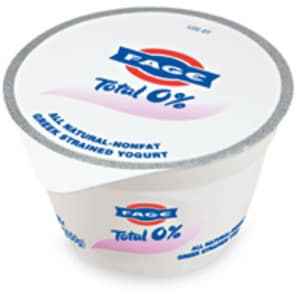 3) Non-Fat Yogurt with 1/4 cup Fiber One or All Bran Cereal: This is a great snack and very filling. The yogurt gives you lots of protein and the fiber one has (of course) fiber, and is only about 30 calories for 1/4 cup! I like Fage 0% Greek Yogurt – which is only 90 calories but packs over 10g protein! You can sweeten the yogurt with a bit of splenda or sugar free preserves, or honey (but don’t go overboard with the honey – 1 Tbsp has about 60 calories!). By the way – one trap a lot of people fall into is topping their yogurt with Granola. Granola (though it sounds healthy) is actually FULL of sugar and calories. 1/4 cup can have up to 100-150 calories!
3) Non-Fat Yogurt with 1/4 cup Fiber One or All Bran Cereal: This is a great snack and very filling. The yogurt gives you lots of protein and the fiber one has (of course) fiber, and is only about 30 calories for 1/4 cup! I like Fage 0% Greek Yogurt – which is only 90 calories but packs over 10g protein! You can sweeten the yogurt with a bit of splenda or sugar free preserves, or honey (but don’t go overboard with the honey – 1 Tbsp has about 60 calories!). By the way – one trap a lot of people fall into is topping their yogurt with Granola. Granola (though it sounds healthy) is actually FULL of sugar and calories. 1/4 cup can have up to 100-150 calories! 4) Dark Chocolate Covered Almonds: Yeah, yeah, I know these are kind of a dessert. But dark chocolate (make sure you get the kind that’s like 70% cacao) is full of antioxidants, and almonds are full of fiber and protein! These also satisfy a sweet tooth really well
4) Dark Chocolate Covered Almonds: Yeah, yeah, I know these are kind of a dessert. But dark chocolate (make sure you get the kind that’s like 70% cacao) is full of antioxidants, and almonds are full of fiber and protein! These also satisfy a sweet tooth really well 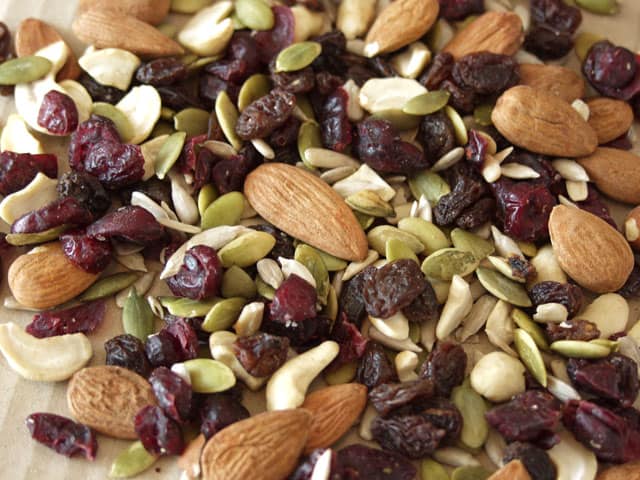 5) Nuts and Dried Fruit: The key here, is to make sure the nuts you buy are just that – nuts. The package should have one ingredient (maybe two if they roast the nuts with salt). My favorites are Almonds, Walnuts and Cashews. The same rule applies for dried fruit – there shouldn’t be any added sugars or oils on the packaging. I like raisins, dried blueberries and dried cranberries. The one trap people fall into with nuts and dried fruit is they take too much – and end up eating like 500 calories. 1/4 cup of almonds is about 150-170 calories (applicable for most nuts). So I’d aim for about 2 Tbsp nuts and 2 Tbsp dried fruits. That should be filling enough to hold you over until your next meal!
5) Nuts and Dried Fruit: The key here, is to make sure the nuts you buy are just that – nuts. The package should have one ingredient (maybe two if they roast the nuts with salt). My favorites are Almonds, Walnuts and Cashews. The same rule applies for dried fruit – there shouldn’t be any added sugars or oils on the packaging. I like raisins, dried blueberries and dried cranberries. The one trap people fall into with nuts and dried fruit is they take too much – and end up eating like 500 calories. 1/4 cup of almonds is about 150-170 calories (applicable for most nuts). So I’d aim for about 2 Tbsp nuts and 2 Tbsp dried fruits. That should be filling enough to hold you over until your next meal! 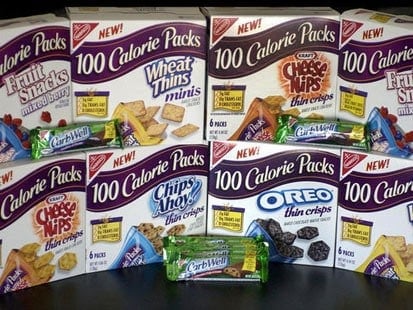 6) 100 Calorie Packs: So this is one of my packaged snacks on the list – 100 calorie packs! These are great because they are already portioned out – and it feels like you’re eating a lot when you get to finish the bag. The other great thing is – they come in like 1,000 different varieties now. They even have 100 calorie pack hostess cupcakes! So pick your favorite, and enjoy!
6) 100 Calorie Packs: So this is one of my packaged snacks on the list – 100 calorie packs! These are great because they are already portioned out – and it feels like you’re eating a lot when you get to finish the bag. The other great thing is – they come in like 1,000 different varieties now. They even have 100 calorie pack hostess cupcakes! So pick your favorite, and enjoy!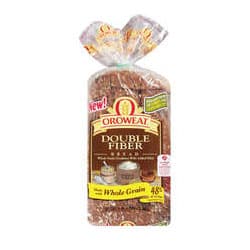 7) 1 Slice of Oroweat Double Fiber Bread (toasted) with 1 Garlic Laughing Cow Cheese Wedge: The great thing about this bread, is it has like 7g fiber and only 70 calories per slice! The Laughing cow cheese wedges are only 30 calories per wedge, and one is more than enough to spread over a slice of bread. I like to toast the bread so it’s crispy, and spread on the cheese while the bread is hot so the cheese gets nice and melty
7) 1 Slice of Oroweat Double Fiber Bread (toasted) with 1 Garlic Laughing Cow Cheese Wedge: The great thing about this bread, is it has like 7g fiber and only 70 calories per slice! The Laughing cow cheese wedges are only 30 calories per wedge, and one is more than enough to spread over a slice of bread. I like to toast the bread so it’s crispy, and spread on the cheese while the bread is hot so the cheese gets nice and melty 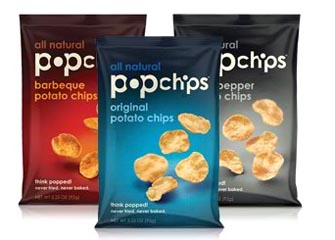 8 ) Pretzels, PopChips, All Bran Fiber Crackers (only take about 100 calories worth – for the Fiber Crackers, that’s about 10 of them): This is a good snack if you want something crispy, salty, but you don’t want to eat a bag of potato chips. By the way – PopChips taste a lot like potato chips but are much healthier! These are also all good packaged snack options when you’re on the run.
8 ) Pretzels, PopChips, All Bran Fiber Crackers (only take about 100 calories worth – for the Fiber Crackers, that’s about 10 of them): This is a good snack if you want something crispy, salty, but you don’t want to eat a bag of potato chips. By the way – PopChips taste a lot like potato chips but are much healthier! These are also all good packaged snack options when you’re on the run. 9) Tea and a 2/3 cup of Kashi Heart to Heart Cereal: When I’m sort of hungry, but not really hungry – I’ll usually make myself a nice cup of hot tea (black tea with cinnamon, cardamom, ginger, splenda, and 1/4 cup of nonfat milk is my favorite). If I want something to munch on, I’ll take a handful of Kashi Heart to Heart Cereal – and depending on how big a handful I take – that’ll end up being ~50 calories.
9) Tea and a 2/3 cup of Kashi Heart to Heart Cereal: When I’m sort of hungry, but not really hungry – I’ll usually make myself a nice cup of hot tea (black tea with cinnamon, cardamom, ginger, splenda, and 1/4 cup of nonfat milk is my favorite). If I want something to munch on, I’ll take a handful of Kashi Heart to Heart Cereal – and depending on how big a handful I take – that’ll end up being ~50 calories.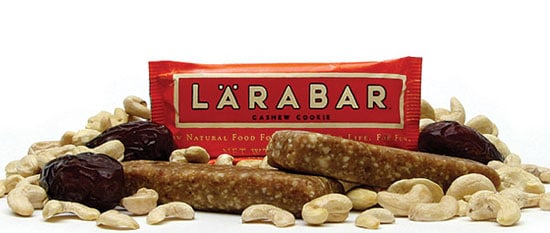 10) Protein Bars: My favorites are CORE Bars, Odwalla Bars and Lara Bars. They all have > 4g fiber; about ~200-300 calories; and at least 5-6g protein. I love all the CORE Bar flavors, But Raw Cashew and Banana Nut are my favs. My favorite Lara Bar flavors are Cashew Cookie and Peanut Butter Cookie. My favorite Odwalla bar flavors are Chocolate Peanut and Dark Chocolate Walnut.
10) Protein Bars: My favorites are CORE Bars, Odwalla Bars and Lara Bars. They all have > 4g fiber; about ~200-300 calories; and at least 5-6g protein. I love all the CORE Bar flavors, But Raw Cashew and Banana Nut are my favs. My favorite Lara Bar flavors are Cashew Cookie and Peanut Butter Cookie. My favorite Odwalla bar flavors are Chocolate Peanut and Dark Chocolate Walnut.Wednesday 24 July 2013
A Cheesy Pizza Alternative
Most pizzas are not something you want to indulge in on a regular basis, especially if you usually down two slices or more. But if you have a weakness for cheesy pie, try this pizza alternative. It's a cinch to whip up, and since the dough is made from slices of packaged quinoa polenta, it's also gluten-free. The warm and juicy baked tomato melts in your mouth, and the basil adds the perfect hint of summer.
Quinoa Polenta Pizza
Serves: 3
Ingredients:
1 tablespoon olive oil
1 tube quinoa polenta, sliced into 15 1/4-inch slices
3 Roma tomatoes, sliced
1/2 cup shredded mozzarella
3 tablespoons chopped fresh basil
1 tablespoon olive oil
1 tube quinoa polenta, sliced into 15 1/4-inch slices
3 Roma tomatoes, sliced
1/2 cup shredded mozzarella
3 tablespoons chopped fresh basil
Directions:
Preheat oven to 350 degrees. Pour oil into a medium-sized saucepan and heat over low heat. Place polenta in the pan and cook on each side for about 10 minutes until golden brown. Remove from heat and place on a foil-lined cookie sheet. Top each piece with 1 slice of tomato, and sprinkle with cheese and fresh basil. Bake for 10 to 15 minutes or until cheese is melted.
Preheat oven to 350 degrees. Pour oil into a medium-sized saucepan and heat over low heat. Place polenta in the pan and cook on each side for about 10 minutes until golden brown. Remove from heat and place on a foil-lined cookie sheet. Top each piece with 1 slice of tomato, and sprinkle with cheese and fresh basil. Bake for 10 to 15 minutes or until cheese is melted.
Nutrition score per serving (5 pieces): 253 calories, 9g fat (3g saturated), 32g carbs, 10g protein, 3g fiber, 3g sugars
Wednesday 17 July 2013
Losing 10 Pounds Could Save Your Life
We all want to lose a few pounds to look smashing in our swimsuits or squeeze into that adorable pair of skinny jeans. Most women – and many men for that matter – are perpetually self-conscious about our muffin top or bulging thighs. In the case of people who are truly overweight or obese, however, the concern over weight is about more than just vanity. If you’re one of these folks — and there are millions in the United States – losing as little as ten pounds can literally help save your life, or at least, extend it by a few years. So, instead of obsessing over how you look in the mirror, think about the health consequences of excess body fat and what you can do create a leaner, healthier you.
Shedding just 5 to 10 percent of your body weight goes a long way in battling chronic diseases – even if you’re still above your ideal weight. Your glucose levels will improve, helping to thwart diabetes, your blood pressure will drop and your cholesterol levels will reach a healthier range. Improvements in blood pressure and cholesterol are especially important because these factors help determine whether or not you have a heart attack or stroke – and heart disease is the number-one cause of death in the United States.
Smaller efforts, Big Impact
The fact that modest weight loss brings tangible health rewards is very good news, as it means that smaller efforts can make a big impact. The thought of losing large amounts of weight can seem daunting – and if you’ve ever watched an episode of “The Biggest Loser,” you may have the impression that starvation and torturous exercise are on the agenda if you want to slim down. But the truth is that some simple lifestyle changes are all you need to lose a small percentage of body fat.
For instance, if you remove two sweetened beverages or servings of potato chips a day from your diet, you’ll consume about 300 fewer calories per day. (A pound of fat is about 3,500 calories, so you’d lose 1 pound every 12 days.) Add a brisk 30-minute walk (which burns about 150 calories for a 155-pound person) five days a week and you’ll lose the weight even faster. That’s totally doable, and you’d lose 10 pounds in a couple of months’ time with these combined modifications.
For painless success, forget restrictive diets altogether and instead focus on eating whole, natural foods while upping your physical activity. Include fruits and vegetables in each meal to help you feel satisfied on fewer calories, as these foods have filling fiber and water. The same is true of whole grains – choose whole-wheat pasta over the white variety, and oatmeal over sugary cold cereals.
Portion control is also key, and serving sizes are probably smaller than you think. For example, 1/2 cup of cooked rice or cooked beans, 1/4 cup of nuts or 3 ounces of cooked fish equal a serving. By staying conscious of the amount of food on your plate, you can lose enough weight to make a major difference in your health – and yes, feel better about your reflection in the mirror.
http://www.undergroundhealth.com/losing-10-pounds-could-save-your-life/
Shedding just 5 to 10 percent of your body weight goes a long way in battling chronic diseases – even if you’re still above your ideal weight. Your glucose levels will improve, helping to thwart diabetes, your blood pressure will drop and your cholesterol levels will reach a healthier range. Improvements in blood pressure and cholesterol are especially important because these factors help determine whether or not you have a heart attack or stroke – and heart disease is the number-one cause of death in the United States.
Smaller efforts, Big Impact
The fact that modest weight loss brings tangible health rewards is very good news, as it means that smaller efforts can make a big impact. The thought of losing large amounts of weight can seem daunting – and if you’ve ever watched an episode of “The Biggest Loser,” you may have the impression that starvation and torturous exercise are on the agenda if you want to slim down. But the truth is that some simple lifestyle changes are all you need to lose a small percentage of body fat.
For instance, if you remove two sweetened beverages or servings of potato chips a day from your diet, you’ll consume about 300 fewer calories per day. (A pound of fat is about 3,500 calories, so you’d lose 1 pound every 12 days.) Add a brisk 30-minute walk (which burns about 150 calories for a 155-pound person) five days a week and you’ll lose the weight even faster. That’s totally doable, and you’d lose 10 pounds in a couple of months’ time with these combined modifications.
For painless success, forget restrictive diets altogether and instead focus on eating whole, natural foods while upping your physical activity. Include fruits and vegetables in each meal to help you feel satisfied on fewer calories, as these foods have filling fiber and water. The same is true of whole grains – choose whole-wheat pasta over the white variety, and oatmeal over sugary cold cereals.
Portion control is also key, and serving sizes are probably smaller than you think. For example, 1/2 cup of cooked rice or cooked beans, 1/4 cup of nuts or 3 ounces of cooked fish equal a serving. By staying conscious of the amount of food on your plate, you can lose enough weight to make a major difference in your health – and yes, feel better about your reflection in the mirror.
http://www.undergroundhealth.com/losing-10-pounds-could-save-your-life/
Saturday 6 July 2013
Creamy Honey Mustard Chicken

| Creamy Honey Mustard Chicken |
Author: Slimming Eats
Serves 2
Ingredients
- 2 chicken breasts (approx 400g total weight), cubed
- 1 onion, finely chopped
- 2 large carrots, sliced
- 4 tsp of dijon mustard (1 syn)
- 1 tablespoon of honey (3 syns)
- 224g of fat free cream cheese (2 HEa’s)
- 320ml of hot chicken stock
- fresh chopped parsley
- salt and black pepper
- low calorie spray
Instructions
- Add the sliced carrots to a steamer pan above boiling hot water, and steam until slightly tender, drain and add to a bowl of cold water to prevent them from cooking any further.
- Spray a frying pan with low calorie spray and brown the onion and the chicken.
- In a jug whisk together the stock, cream cheese, honey and mustard
- Pour this into the frying pan and slowly bring to a boil, reduce heat, add carrots and simmer covered for about 15 mins, the sauce should slightly thicken, if it gets too thick, stir in a little more stock.
- Season with salt and black pepper and sprinkle with fresh chopped Italian parsley.
- Serve with your choice of sides. I served this with steamed rice and sauteed zucchini (courgette).
The later you stay up, the more you eat, study shows

Ryan McVay / Getty Images stock
Dude, it's time to go to bed. A new study found people who got only four hours of sleep for five consecutive nights ate more fatty foods and gained 2.2. pounds on average.
New research published today in the journal Sleep confirms what scientists have been telling us for some time now: the later you stay up, the more sleep you lose, the more calories you’ll eat, and the more weight you’ll gain.
In a first-of-its-kind experiment, sleep researchers from the Sleep and Chronobiology Laboratory at the Perelman School of Medicine at University of Pennsylvania, found that when test subjects went to bed at 4 a.m. and woke four hours later at 8 a.m., they consumed about 550 calories after 11 p.m., far more than their bodies needed. In addition, more of those 550 calories came from fat, resulting in a weight gain, on average, of about 1 kilo (2.2. pounds) after five consecutive nights of limited sleep.
Research over the years has produced similar findings, but the new Penn study is significant because it used 225 people. And because the research took place in a lab, scientists were able to control for a variety of factors.
Andrea Spaeth, a doctoral candidate and the study’s lead author, called the logistics “a nightmare” but worthwhile because it increased the power of the results.
Spaeth said participants in the study could eat almost whenever they wanted and as much as they wanted. Meal sizes did not differ between baseline days and the five experimental days, or between the sleep-deprived group and a small control group. “But [the deprived group] ate more times through the day and shifted their calorie intake toward late night,” she explained. “The next morning they’d actually eat less.”
African-Americans were especially vulnerable to the effects of sleep deprivation. African-American men gained the most weight (about 1.7 kilos or 3.7 pounds), followed by African-American females and white men (both just under 1 kilo or 2.2 pounds), and white women (almost one-third kilo or .7 pounds).
“This is the first racial difference in such a study,” explained Kenneth Wright, associate professor in the department of integrative biology and the director of the Sleep and Chronobiology Laboratory at the University of Colorado, Boulder. “This provides experimental evidence for what we see in the epidemiological literature, that African-Americans seem to be more influenced by the effects of sleep loss.”
Why that is, and why exactly anybody gains weight with sleep loss is still somewhat mysterious, Wright explained. In an experiment released earlier this year, his lab found that key hormones regulating food intake, like ghrelin and leptin, were within normal levels in sleep deprived people, but they still ate more.
It could be, he speculated, that control centers of the brain – i.e., willpower – are weakened, causing us to seek rewarding, pleasurable food, which could explain why we tend to eat fattier food late at night. We’re seeking comfort. But there are other factors at work, too.
“We have biological mechanisms to prompt us to consume more energy” when we’re awake, Spaeth said. But such evolutionary adaptation does not account for the fact that modern man in western society no longer has to hunt down an antelope or dig up a tuber to get food. All we have to do is open the refrigerator. “What we’re doing is really overcompensating for small increases in energy requirements.”
This is partly why shift work can be so detrimental to health, Wright said. “Shift work goes against the fundamental biological clock in our brain. We evolved to be awake during the day when we are supposed to be physically active and consuming food. When we are awake at night, the circadian clock does not adapt. There are consequences to that…That’s why shift workers are at greater risk for many health problems we see in modern society.”
Shift work isn’t going away any time soon, though. Wright said finding ways to compensate for this circadian havoc is a key goal of chronobiological research.
Subscribe to:
Posts (Atom)
